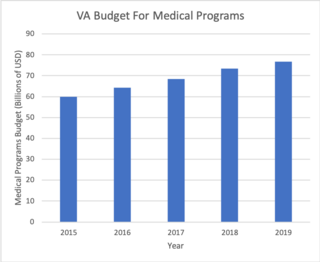
The Veterans Health Administration (VHA) is the component of the United States Department of Veterans Affairs (VA) led by the Under Secretary of Veterans Affairs for Health that implements the healthcare program of the VA through a nationalized healthcare service in the United States, providing healthcare and healthcare-adjacent services to veterans through the administration and operation of 146 VA Medical Centers (VAMC) with integrated outpatient clinics, 772 Community Based Outpatient Clinics (CBOC), and 134 VA Community Living Centers Programs. It is the largest division in the department, and second largest in the entire federal government, employing over 350,000 employees. All VA hospitals, clinics and medical centers are owned by and operated by the Department of Veterans Affairs, and all of the staff employed in VA hospitals are federal employees. Because of this, veterans that qualify for VHA healthcare do not pay premiums or deductibles for their healthcare but may have to make copayments depending on the medical procedure. VHA is not a part of the US Department of Defense Military Health System.

Mental health encompasses emotional, psychological, and social well-being, influencing cognition, perception, and behavior. According to World Health Organization (WHO), it is a "state of well-being in which the individual realizes his or her abilities, can cope with the normal stresses of life, can work productively and fruitfully, and can contribute to his or her community". It likewise determines how an individual handles stress, interpersonal relationships, and decision-making. Mental health includes subjective well-being, perceived self-efficacy, autonomy, competence, intergenerational dependence, and self-actualization of one's intellectual and emotional potential, among others. From the perspectives of positive psychology or holism, mental health may include an individual's ability to enjoy life and to create a balance between life activities and efforts to achieve psychological resilience. Cultural differences, subjective assessments, and competing professional theories all affect how one defines "mental health". Some early signs related to mental health difficulties are sleep irritation, lack of energy, lack of appetite, thinking of harming oneself or others, self-isolating, and frequently zoning out.
Partial hospitalization, also known as PHP, is a type of program used to treat mental illness and substance abuse. In partial hospitalization, the patient continues to reside at home, but commutes to a treatment center up to seven days a week. Partial hospitalization focuses on the overall treatment of the individual and is intended to avert or reduce in-patient hospitalization.
Psychiatric nursing or mental health nursing is the appointed position of a nurse that specialises in mental health, and cares for people of all ages experiencing mental illnesses or distress. These include: neurodevelopmental disorders, schizophrenia, schizoaffective disorder, mood disorders, addiction, anxiety disorders, personality disorders, eating disorders, suicidal thoughts, psychosis, paranoia, and self-harm.

Long-term care (LTC) is a variety of services which help meet both the medical and non-medical needs of people with a chronic illness or disability who cannot care for themselves for long periods. Long-term care is focused on individualized and coordinated services that promote independence, maximize patients' quality of life, and meet patients' needs over a period of time.

The Community Mental Health Act of 1963 (CMHA) was an act to provide federal funding for community mental health centers and research facilities in the United States. This legislation was passed as part of John F. Kennedy's New Frontier. It led to considerable deinstitutionalization.

Deinstitutionalisation is the process of replacing long-stay psychiatric hospitals with less isolated community mental health services for those diagnosed with a mental disorder or developmental disability. In the late 20th century, it led to the closure of many psychiatric hospitals, as patients were increasingly cared for at home, in halfway houses and clinics, in regular hospitals, or not at all.
Program of All-inclusive Care for the Elderly (PACE) are programs within the United States that provide comprehensive health services for individuals age 55 and over who are sufficiently frail to be categorized as "nursing home eligible" by their state's Medicaid program. The ultimate goal of PACE programs is to keep eligible older adults out of nursing homes and within their communities for as long as possible. Services include primary and specialty medical care, nursing, nutrition, social services, therapies, pharmaceuticals, day health center services, home care, health-related transportation, minor modification to the home to accommodate disabilities, and anything else the program determines is medically necessary to maximize a member's health. If you or a loved one are eligible for nursing home level care but prefer to continue living at home, a PACE program can provide expansive health care and social opportunities during the day while you retain the comfort and familiarity of your home outside of day hours.
Psychiatric rehabilitation, also known as psych social rehabilitation, and sometimes simplified to psych rehab by providers, is the process of restoration of community functioning and well-being of an individual diagnosed in mental health or emotional disorder and who may be considered to have a psychiatric disability.

Patient dumping or homeless dumping is the practice of hospitals and emergency services inappropriately releasing homeless or indigent patients to public hospitals or on the streets instead of placing them with a homeless shelter or retaining them, especially when they may require expensive medical care with minimal government reimbursement from Medicaid or Medicare. The term homeless dumping has been used since the late 19th century and resurfaced throughout the 20th century alongside legislation and policy changes aimed at addressing the issue. Studies of the issue have indicated mixed results from the United States' policy interventions and have proposed varying ideas to remedy the problem.
Services for mental health disorders provide treatment, support, or advocacy to people who have psychiatric illnesses. These may include medical, behavioral, social, and legal services.

The Utah State Hospital (USH) is a mental hospital located in eastern Provo, Utah, United States of America. The current superintendent is Dallas Earnshaw.

The lunatic asylum, insane asylum or mental asylum was an early precursor of the modern psychiatric hospital.
Intermediate Care Facilities for Individuals with Intellectual Disabilities (ICF/IID), formerly known as Intermediate Care Facilities for Mental Retardation (ICF/MR), is an American Medicaid-funded institutional long-term support and service (LTSS) for people with intellectual disabilities or related conditions. Section 1905(d) of the Social Security Act enacted benefits and made funding available for "institutions" for individuals with intellectual or related conditions. According to federal law 42 CFR § 440.150 the purpose of ICD/IIDs is to "furnish health or rehabilitative services to persons with Intellectual Disability or persons with related conditions."
The primary care behavioral health (PCBH) consultation model is a psychological approach to population-based clinical health care that is simultaneously co-located, collaborative, and integrated within the primary care clinic. The goal of PCBH is to improve and promote overall health within the general population. This approach is important because approximately half of all patients in primary care present with psychiatric comorbidities, and 60% of psychiatric illness is treated in primary care.

In a study in Western societies, homeless people have a higher prevalence of mental illness when compared to the general population. They also are more likely to suffer from alcoholism and drug dependency. It is estimated that 20–25% of homeless people, compared with 6% of the non-homeless, have severe mental illness. Others estimate that up to one-third of the homeless have a mental illness. In January 2015, the most extensive survey ever undertaken found 564,708 people were homeless on a given night in the United States. Depending on the age group in question and how homelessness is defined, the consensus estimate as of 2014 was that, at minimum, 25% of the American homeless—140,000 individuals—were seriously mentally ill at any given point in time. 45% percent of the homeless—250,000 individuals—had any mental illness. More would be labeled homeless if these were annual counts rather than point-in-time counts. Being chronically homeless also means that people with mental illnesses are more likely to experience catastrophic health crises requiring medical intervention or resulting in institutionalization within the criminal justice system. Majority of the homeless population do not have a mental illness. Although there is no correlation between homelessness and mental health, those who are dealing with homelessness are struggling with psychological and emotional distress. The Substance Abuse and Mental Health Services Administration conducted a study and found that in 2010, 26.2 percent of sheltered homeless people had a severe mental illness.
Deemed status is a hospital accreditation for hospitals in the United States.
A safety net hospital is a type of medical center in the United States that by legal obligation or mission provides healthcare for individuals regardless of their insurance status or ability to pay. This legal mandate forces safety net hospitals (SNHs) to serve all populations. Such hospitals typically serve a proportionately higher number of uninsured, Medicaid, Medicare, Children's Health Insurance Program (CHiP), low-income, and other vulnerable individuals than their "non-safety net hospital" counterpart. Safety net hospitals are not defined by their ownership terms; they can be either publicly or privately owned. The mission of safety net hospitals is rather to provide the best possible care for those who are barred from health care due to the various possible adverse circumstances. These circumstances mostly revolve around problems with financial payments, insurance plans, or health conditions. Safety net hospitals are known for maintaining an open-door policy for their services.
A hospital readmission is an episode when a patient who had been discharged from a hospital is admitted again within a specified time interval. Readmission rates have increasingly been used as an outcome measure in health services research and as a quality benchmark for health systems. Generally, higher readmission rate indicates ineffectiveness of treatment during past hospitalizations. Hospital readmission rates were formally included in reimbursement decisions for the Centers for Medicare and Medicaid Services (CMS) as part of the Patient Protection and Affordable Care Act (ACA) of 2010, which penalizes health systems with higher than expected readmission rates through the Hospital Readmission Reduction Program. Since the inception of this penalty, there have been other programs that have been introduced, with the aim to decrease hospital readmission. The Community Based Care Transition Program, Independence At Home Demonstration Program, and Bundled Payments for Care Improvement Initiative are all examples of these programs. While many time frames have been used historically, the most common time frame is within 30 days of discharge, and this is what CMS uses.
The United States has experienced two waves of deinstitutionalization, the process of replacing long-stay psychiatric hospitals with less isolated community mental health services for those diagnosed with a mental disorder or developmental disability.









